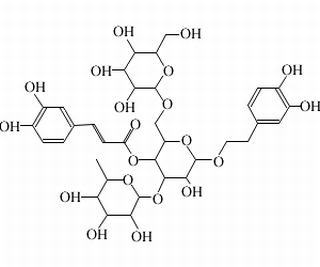Home
Products
Echinacoside



| Product Name | Echinacoside |
| Price: | $46 / 20mg |
| Catalog No.: | CN06992 |
| CAS No.: | 82854-37-3 |
| Molecular Formula: | C35H46O20 |
| Molecular Weight: | 786.72 g/mol |
| Purity: | >=98% |
| Type of Compound: | Phenylpropanoids |
| Physical Desc.: | Powder |
| Source: | The rhizomes of Cistanche tubulosa (Schenk) Wight |
| Solvent: | DMSO, Pyridine, Methanol, Ethanol, etc. |
| SMILES: | OC[C@H]1O[C@@H](OC[C@H]2O[C@@H](OCCc3ccc(c(c3)O)O)[C@@H]([C@H]([C@@H]2OC(=O)/C=C/c2ccc(c(c2)O)O)O[C@@H]2O[C@@H](C)[C@@H]([C@H]([C@H]2O)O)O)O)[C@@H]([C@H]([C@@H]1O)O)O |
| Contact us | |
|---|---|
| First Name: | |
| Last Name: | |
| E-mail: | |
| Question: | |
| Description | Echinacoside is a natural polyphenolic compound, has various kinds of pharmacological activities, such as antioxidative, anti-inflammatory, neuroprotective, hepatoprotective, nitric oxide radical-scavenging and vasodilative ones.IC50 value:Target:in vitro: Echinacoside(ECH) dose dependently inhibited HEWL aggregation, and this inhibition occurred in different fiber-forming stages. ECH could also scavenge the DPPH and OH free radicals in a concentration-dependent manner. ECH could increase viability of rat pheochromocytoma PC12 cells injured by Aβ and suppress the increase in intracellular reactive oxygen species (ROS) triggered by Aβ [1]. Transient treatment with echinacoside inhibits cytochrome c release and caspase-3 activation caused by ensuing rotenone exposure via activating Trk-extracellular signal-regulated kinase (ERK) pathway in neuronal cells [2]. ECH caused a significant increase in cell proliferation, ALP activity, COL I contents, OCN levels and an enhancement of mineralization in osteoblasts at the concentration range from 0.01 to 10nmol·L(-1) (p<0.05), suggesting that ECH has a stimulatory effect on osteoblastic bone formation or has potential activity against osteoporosis [4]. in vivo: In OVX rats, the increases of body weight, serum hydroxyproline (HOP) levels, and the decreases of uterus wet weight and BMD were significantly reversed by ECH treatment [3]. Echinacoside (60 mg/kg) was given intraperitoneally to mice at 1 h prior to GalN/LPS exposure. Pretreatment with echinacoside remarkably improved the survival rate of GalN/LPS-treated mice and attenuated acute hepatotoxicity, as demonstrated by decreased ALT levels and improved histological signs. Echinacoside shows both anti-apoptotic and anti-inflammatory properties, characterized by a substantial inhibition of hepatocyte apoptosis and a significant reduction in the inflammatory markers, including myeloperoxidase, extracellular nucleosomes, high-mobility group box 1, and inflammatory cytokines in the plasma of mice, which may be important mechanisms related to its protective effect [5]. |
| Density | 1.7±0.1 g/cm3 |
| Boiling Point | 1062.7±65.0 °C at 760 mmHg |
| Flash Point | 327.9±27.8 °C |
| Exact Mass | 786.258240 |
| PSA | 324.44000 |
| LogP | 0.14 |
| Vapour Pressure | 0.0±0.3 mmHg at 25°C |
| Storage condition | 2-8°C |